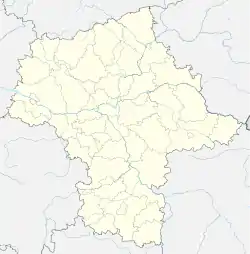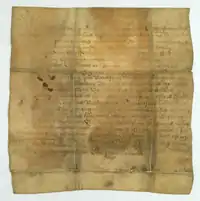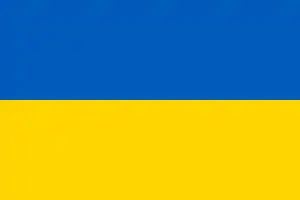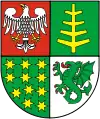Ostrów Mazowiecka
Ostrów Mazowiecka [ˈɔstruf mazɔˈvʲɛt͡ska] (![]() listen) is a town in northeastern Poland with 23,486 inhabitants (2004). Situated in the Masovian Voivodeship (since 1999), previously in Ostrołęka Voivodeship (1975–1998). It is the capital of Ostrów Mazowiecka County.
listen) is a town in northeastern Poland with 23,486 inhabitants (2004). Situated in the Masovian Voivodeship (since 1999), previously in Ostrołęka Voivodeship (1975–1998). It is the capital of Ostrów Mazowiecka County.
Ostrów Mazowiecka | |
|---|---|
 Town hall | |
 Flag  Coat of arms | |
 Ostrów Mazowiecka  Ostrów Mazowiecka | |
| Coordinates: 52°48′N 21°54′E | |
| Country | |
| Voivodeship | Masovian |
| County | Ostrów Mazowiecka County |
| Gmina | Ostrów Mazowiecka (urban gmina) |
| Established | 14th century |
| Town rights | 1434 |
| Government | |
| • Mayor | Jerzy Bauer |
| Area | |
| • Total | 22.09 km2 (8.53 sq mi) |
| Elevation | 110 m (360 ft) |
| Population (2013[1]) | |
| • Total | 22,796 |
| • Density | 1,000/km2 (2,700/sq mi) |
| Time zone | UTC+1 (CET) |
| • Summer (DST) | UTC+2 (CEST) |
| Postal code | 07-300, 07-302 |
| Area code(s) | +48 029 |
| Car plates | WOR |
| Website | http://www.ostrowmaz.pl |
History

Ostrów was granted town rights in 1434 by Duke Bolesław IV of Warsaw.[2] Its name comes from the Old Polish word ostrowa.[2] In 1461 a parish school was founded in the town.[2] In 1514, Duchess Anna Radziwiłł, who is commemorated in the town with a monument, established four annual fairs and a weekly market, boosting the development of Ostrów.[2] In the 16th century Polish King Sigismund II Augustus built a residence in Ostrów.[2] Ostrów was a Polish royal town, administratively located in the Masovian Voivodeship in the Greater Poland Province of the Polish Crown.
The town's inhabitants took part in the Kościuszko Uprising of 1794,[2] however, the following year it was annexed by Prussia in the Third Partition of Poland. In 1807 it was included in the short-lived Polish Duchy of Warsaw, and in 1815 it became part of so-called Congress Poland within the Russian Partition of Poland. Many inhabitants took part in several battles of the Polish January Uprising of 1863–1864 against Russia, and an insurgent hospital was located in Ostrów.[2] Ostrów was subjected to anti-Polish repressions, was one of the sites of Russian executions of Polish insurgents, and there are memorials at the execution sites.[2] Despite such circumstances, in the following decades, various Polish organizations were founded in Ostrów.[2] In the 19th century, the town saw a significant influx of Jewish settlers as a result of Russian discriminatory policies, and according to the 1897 census, 5,660 inhabitants out of 10,471 were Jews.[3] During World War I, it was occupied by Germany, in 1918 it became part of restored independent Poland, and in 1920 a battle was fought on the town's outskirts during the Polish–Soviet War.[2]

During the joint German-Soviet invasion of Poland, which started World War II, Ostrów Mazowiecka was captured by Germany on September 8, 1939,[2] and in mid-September the Einsatzgruppe V entered the town to commit various atrocities against the population.[4] Already on 19 September the Germans arrested nine Poles, including chairmen of local veterans' organizations Włodzimierz Gadomski and Jan Radbalski.[5] On 9 November 1939, one of the German soldiers set fire to the buildings on 3-ego Maja Street. The German authorities accused the Jews of starting the fire. On 11 November (though according to other sources, on 10 November) 500–800 Jews were killed.[6] The Polish underground resistance movement was organized already in autumn of 1939.[2] On May 25, 1943, the Polish resistance successfully assassinated the chief of the local German administration, in retaliation for which the Germans massacred about 140 Poles.[2] The German occupation ended in 1944.
International relations
Twin towns – Sister cities
Ostrów Mazowiecka is twinned with:
 Brembate di Sopra, Italy
Brembate di Sopra, Italy Ryazan, Russia
Ryazan, Russia Iziaslav, Ukraine
Iziaslav, Ukraine
Notable people
- Jadwiga Długoborska (1899–1944), teacher, social and charity worker
- Jan Dołęga-Zakrzewski (1866–1936), politician, surveyor, publicist, mayor of Ostrów Mazowiecka (1930-1933)
- Krystyna Sienkiewicz (1934–2017), actress and singer
Gallery
 Church of the Assumption
Church of the Assumption Duchess Anna Radziwiłł monument
Duchess Anna Radziwiłł monument Mensa carnifiucium
Mensa carnifiucium Municipal park
Municipal park
References
- Demographic Yearbook of Poland 2014 Archived 2016-07-09 at the Wayback Machine
- Andrzej Mierzwiński. "Spacerkiem przez dzieje". Urząd Miasta Ostrów Mazowiecka (in Polish). Retrieved 1 November 2020.
- "Archived copy". Archived from the original on 2016-05-05. Retrieved 2016-05-06.CS1 maint: archived copy as title (link)
- Maria Wardzyńska, Był rok 1939. Operacja niemieckiej policji bezpieczeństwa w Polsce. Intelligenzaktion, IPN, Warszawa, 2009, p. 54 (in Polish)
- Wardzyńska, p. 112
- "Archived copy". Archived from the original on 2016-06-02. Retrieved 2016-05-06.CS1 maint: archived copy as title (link)
